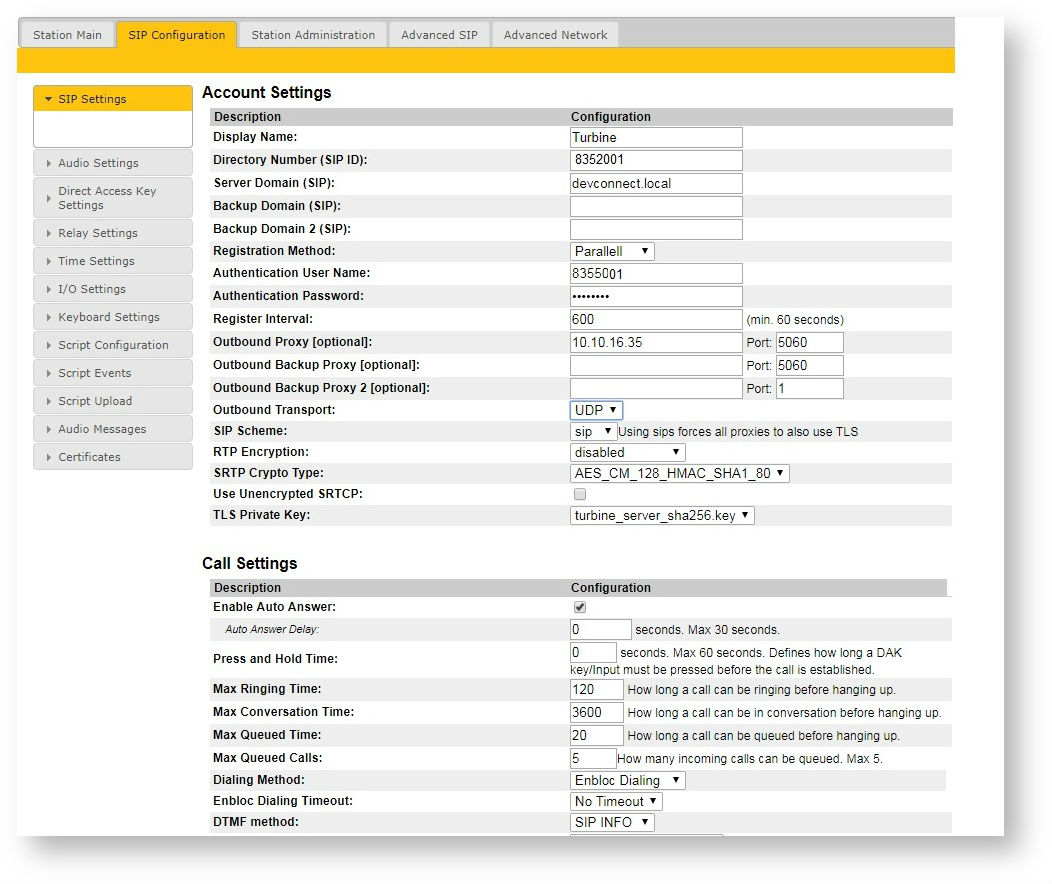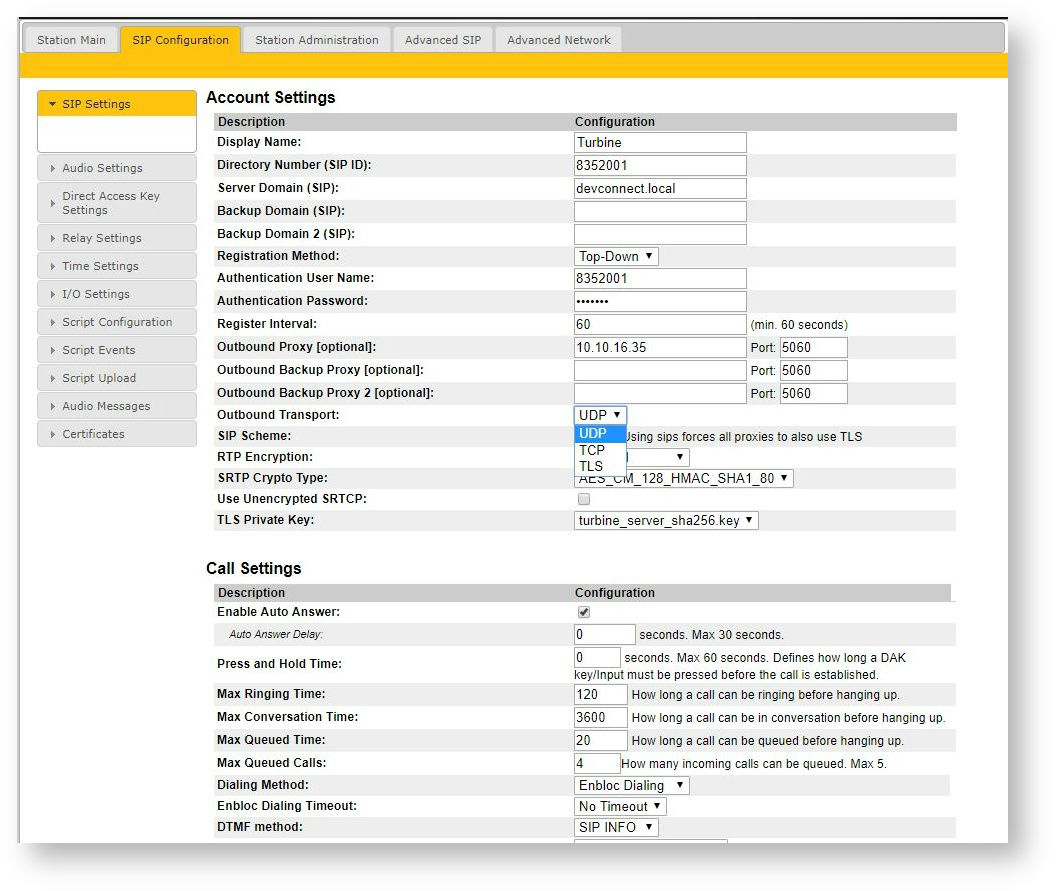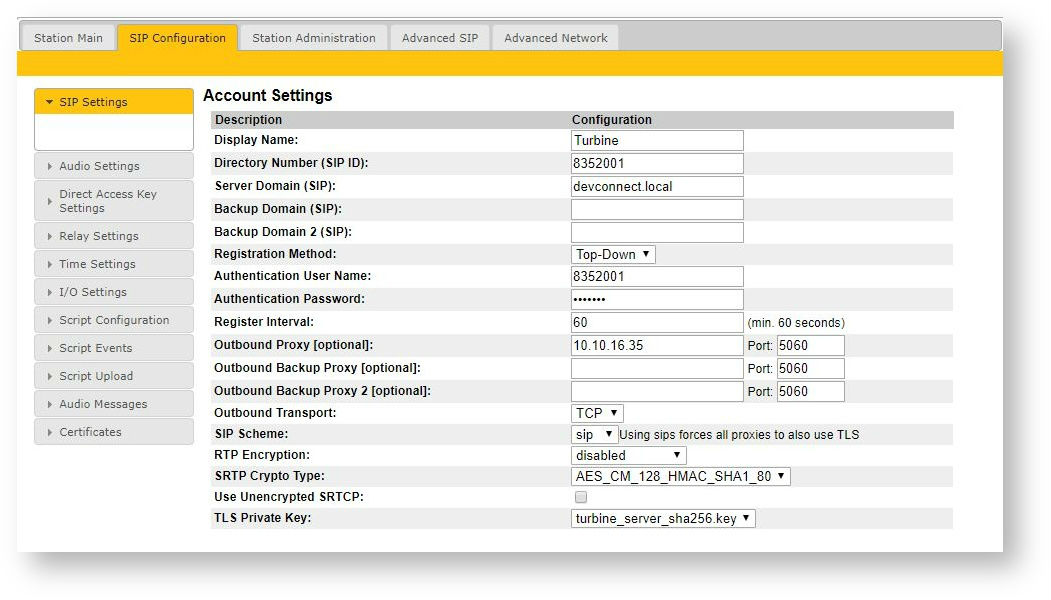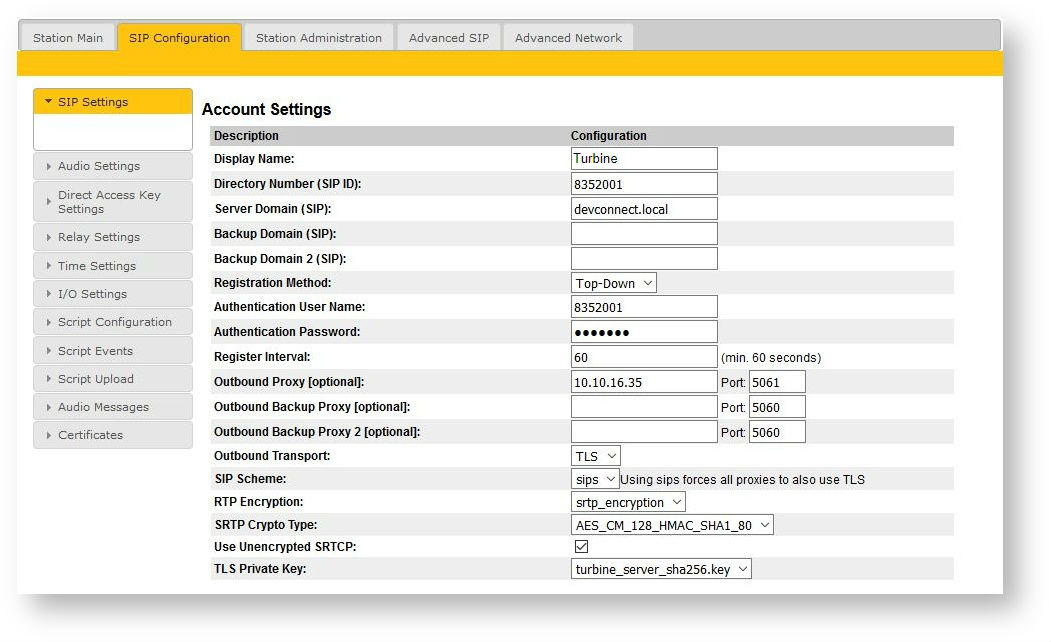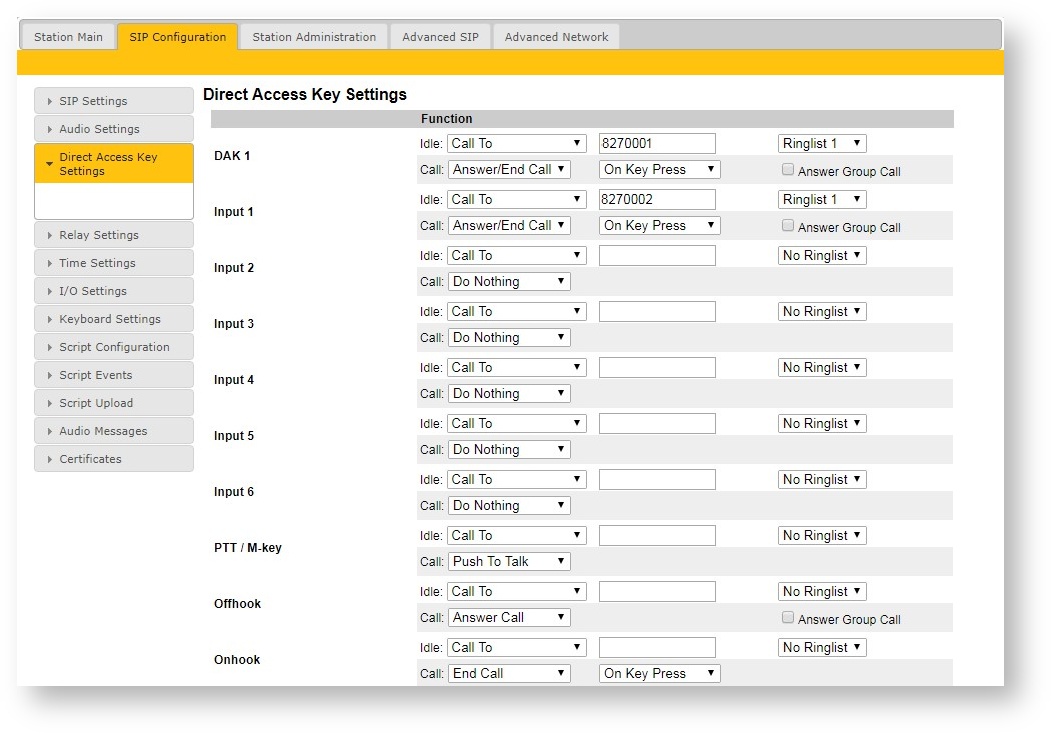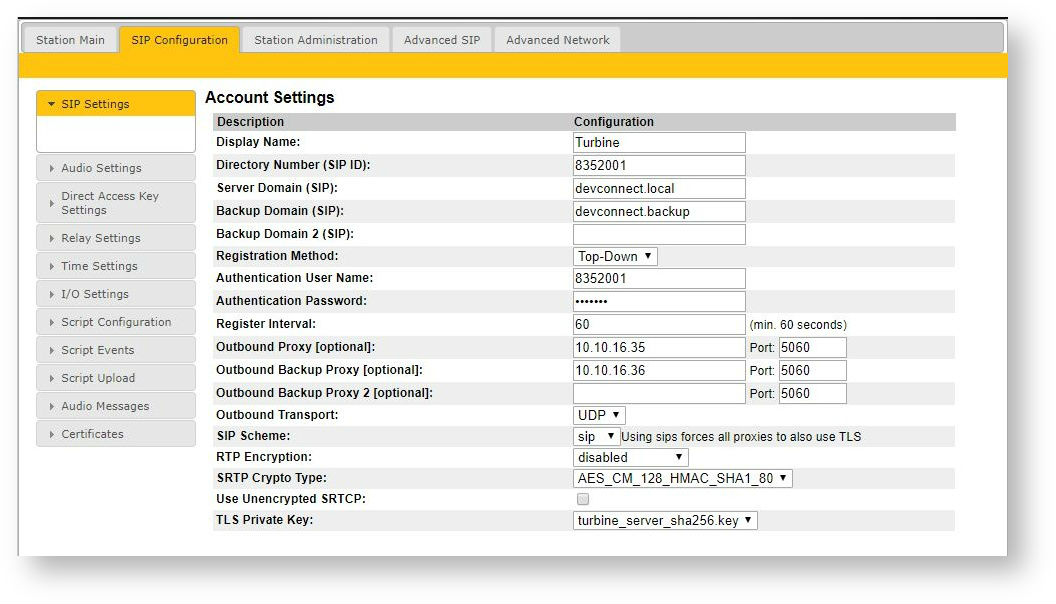Difference between revisions of "Avaya Aura CM 7.1 configuration"
From Zenitel Wiki
(→Add certificate on Turbine station) |
(→Add certificate on Turbine station) |
||
| Line 229: | Line 229: | ||
*Reboot Turbine station ( '''Station Administration''' → '''Reboot''' → '''Reboot''' ) | *Reboot Turbine station ( '''Station Administration''' → '''Reboot''' → '''Reboot''' ) | ||
<br> | <br> | ||
| − | {{Note| | + | {{Note|Uploading a certificate is only needed when using SIP TLS}} |
<br style="clear:both;" /> | <br style="clear:both;" /> | ||
Latest revision as of 22:06, 23 April 2018
Contents
Overview
The configuration and verification operations in this document are performed through the Site Administration tool and via the System Manager web interface for the Avaya section and with the standard web interface for Turbine station configuration (we recommend Firefox or Chrome).
Except where stated, the parameters in all the procedures are the default settings and are supplied for reference only. For all other information such as provisioning of the trunks, call coverage, extensions, and voicemail, please refer to the documentation in Related Articles.
The procedures fall into the following areas:
- Configure IP Codec Set
- Configure SIP User
- Configure SIP settings on the Turbine station
- Configure Account settings on the Turbine station
- Verification
Prepare for Installation
Plan your installation by preparing configuration data you would need to set up Turbine.
| Parameter | Value |
|---|---|
| Station Name* | Turbine |
| Directory Number (SIP ID)* | 8279999 |
| Authentication User Name* | same as defined in section "Configure SIP User" |
| Authentication Password* | same as defined in section "Configure SIP User" |
| Server Domain (SIP) address* | devconnect.local |
| Backup Domain (SIP) address | - |
| Outbound Proxy (optional for UDP) | 10.10.16.77 |
| Outbound Proxy Port (default 5060) | 5061 for TLS |
| Outbound Backup Proxy (optional for UDP) | - |
| Outbound Backup Proxy Port (default 5060) | - |
| Outbound Transport | UDP/TCP/TLS |
| SIP Scheme (default sip)** | sip/sips |
| RTP Encryption** | only if are using SRTP |
| SRTP Crypto Type** | only for SRTP |
| TLS Private Key** | only for TLS |
*=required **=required for TLS and SRTP crypto type
Avaya Aura Communication Manager Configuration
Configure IP Codec Set
The IP Codec set must be configured with the codecs for use by IP endpoints.
Enter the command change ip-codec-set x where x is the relevant codec set and set the Audio Codec to be used on Page 1.
In the example below, codecs G.711MU and G.711A are configured. Media Encryption (1-srtp-aescm128-hmac80) was set for this test with Encrypted SRTP: best-effort.
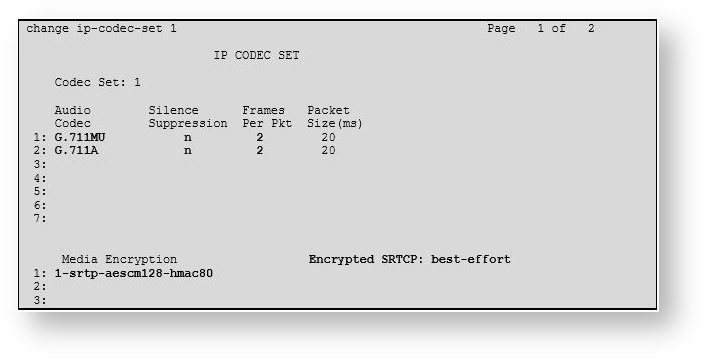
Configure SIP User
A SIP user must be added for each Turbine endpoint required. Navigate to the System Manager web interface, in this case https://<IP Address>/SMGR and log in with the relvant credentials.
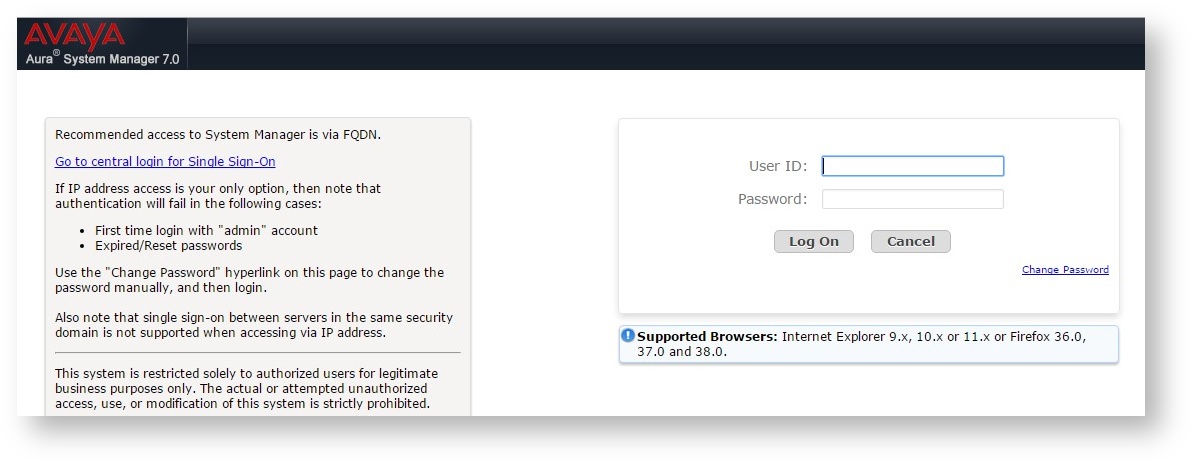
From the Dashboard, select Users > User Management > Manage Users > New
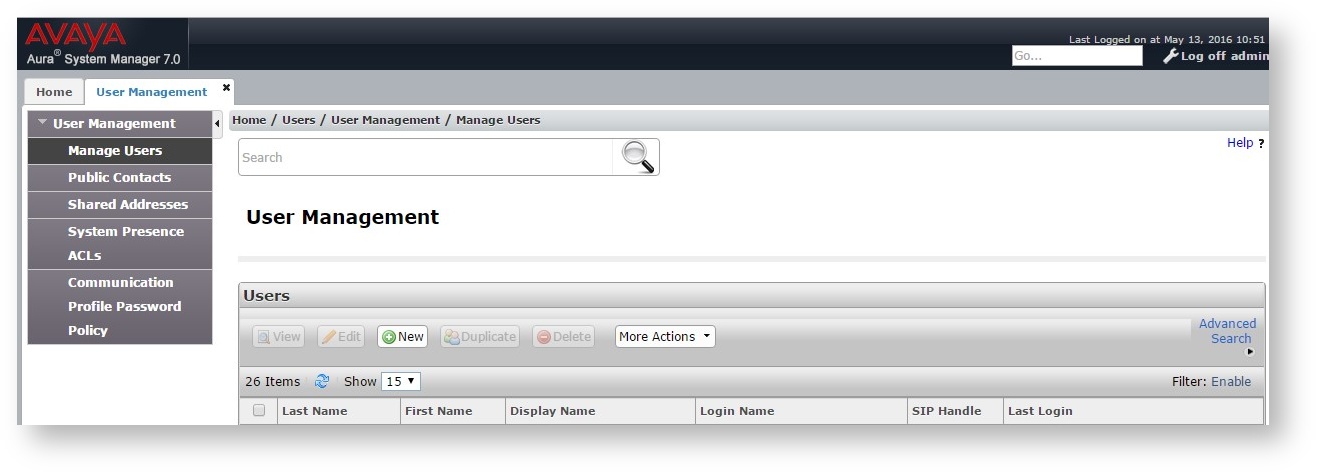
On the Identity tab:
- Enter an identifying Last Name and First Name
- Enter an appropriate Login Name
- Set User Type to Basic
- Set a password in the Password and Confirm Password fields
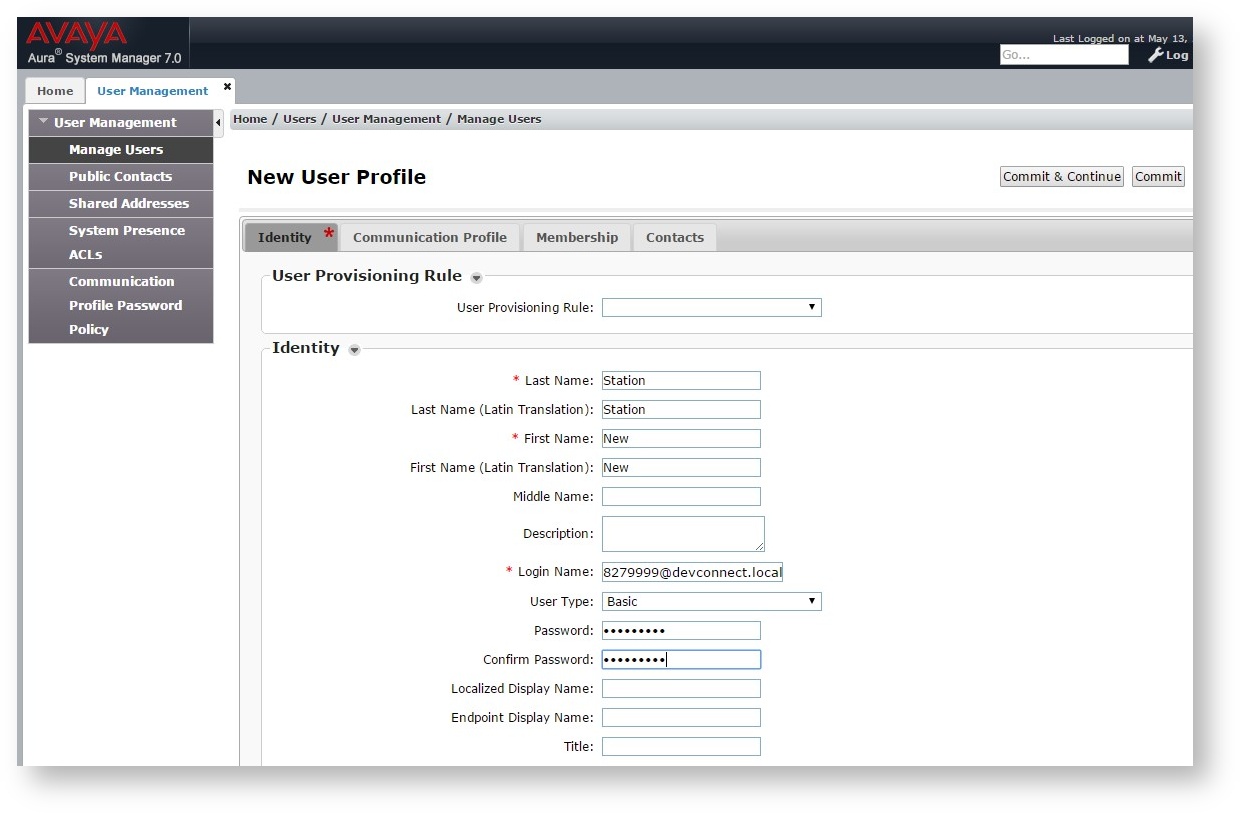
On the Communication Profile tab:
- Enter and confirm a Communication Profile Password (used when logging into the SIP endpoint)
- Under Communication Address click New
- Select Avaya SIP from the Type dropdown box
- Enter the Fully Qualified Address of the new SIP user
- Click Add when done
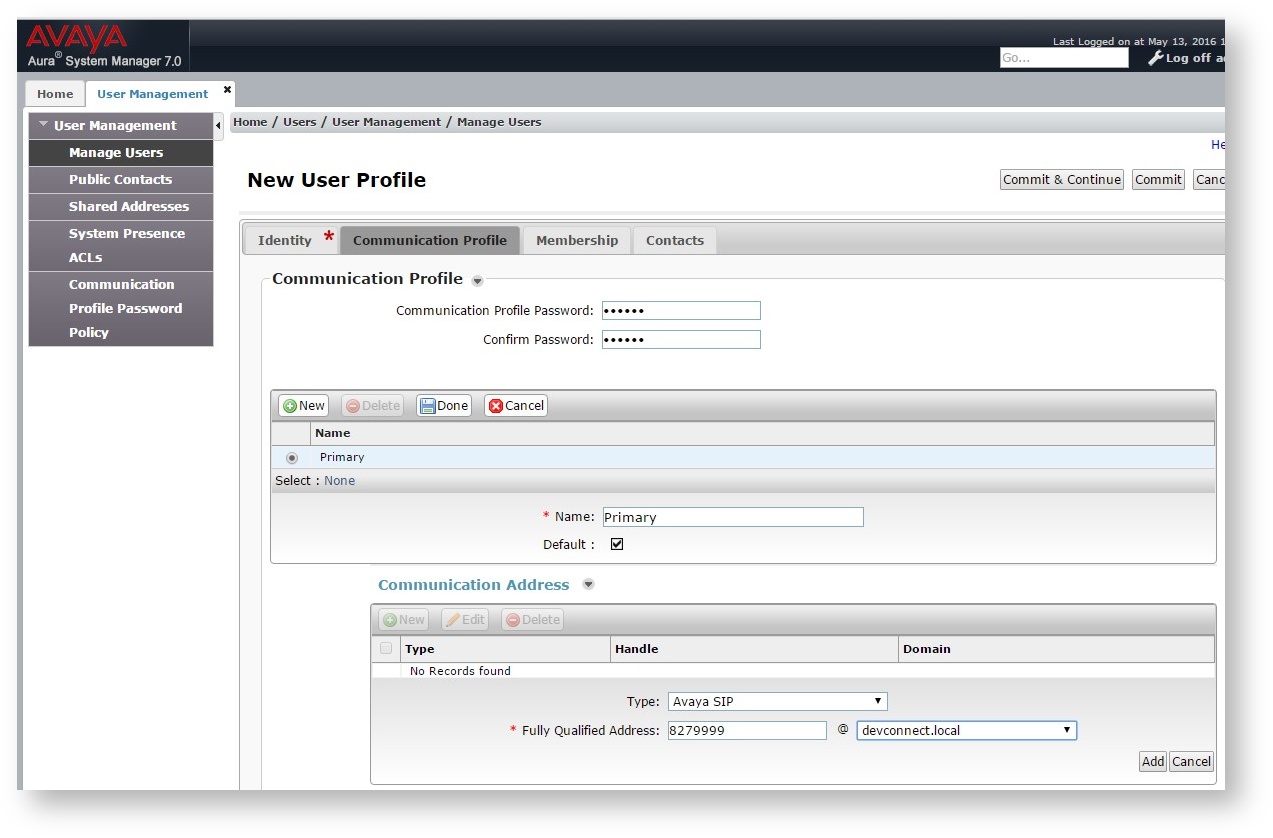
Continue to scroll down on the same page and enter the Primary Session Manager, Origination Application Sequence, Termination Application Sequence and Home Location relevant to the implementation.
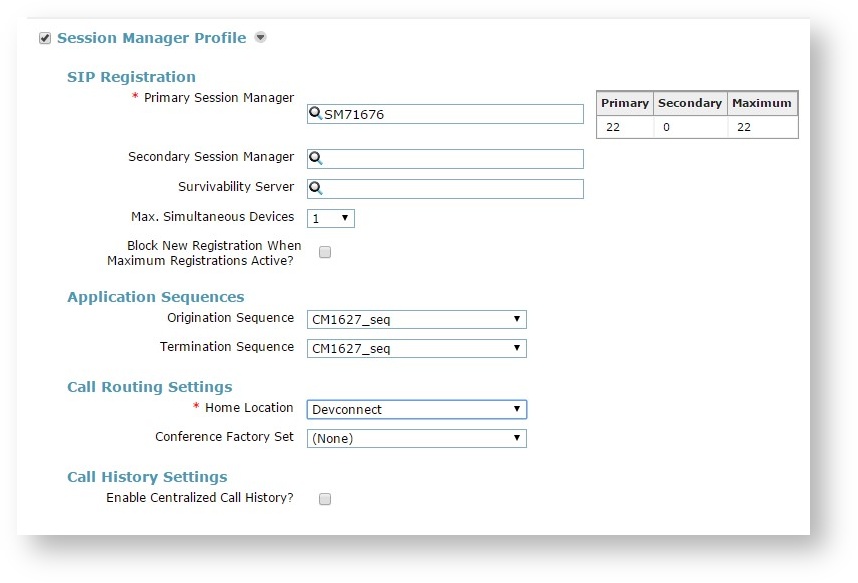
- Scroll down the page to the CM Endpoint Profile section
- Select the Communication Manager system from the System dropdown box
- Select Endpoint as the Profile Type
- Enter the Extension number you wish to use
- Select 9620SIP_DEFAULT_CM_7_0 as the Template
- Set IP as the Port
- Click Commit (not shown) when done
Repeat this procedure for every SIP extension required.
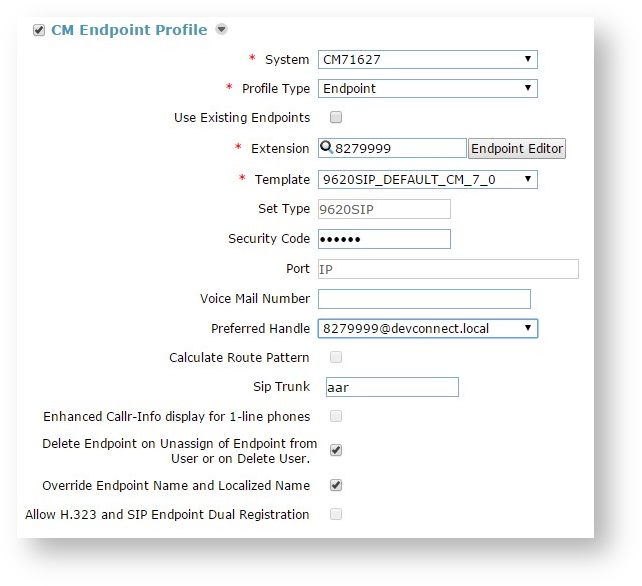
Configure Turbine Station
The following steps are for the configuration of the Turbine station using its web interface:
- Launch Web Interface
- Add Root Certificate
- Administer SIP Settings
- Configure Direct Access Key
Launch Web Interface
To access the Turbine station web interface:
- Enter http://<ipaddress> in an Internet browser where <ipaddress> is the IP address of the Turbine station
- Log in with the appropriate credentials (default username: admin, password: alphaadmin)
The IP-StationWeb screen displays the Station Information.
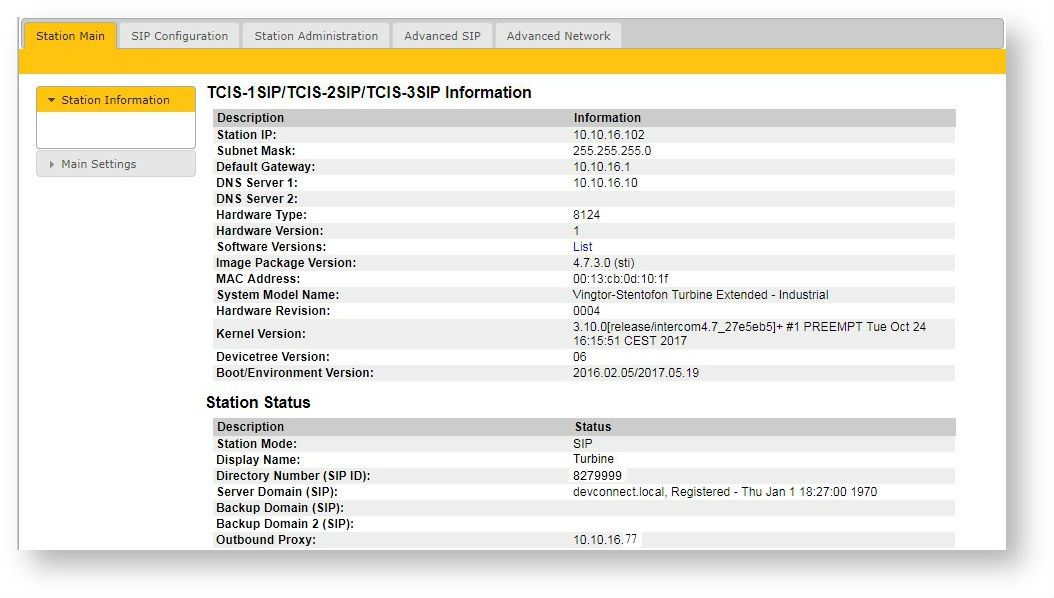
Administer Main Settings
Under the Station Main tab:
- Select Main Settings
- Under Model select :
- For TCIS stations select:
- Kit (TKIS-2SIP),
- Normal (TCIS-1SIP, TCIS-2SIP, TCIS-3SIP),
- OLED Labels (TCIS-4SIP, TCIS-5SIP),
- Scrolling Station (TCIS-6SIP),
- For TCIV stations select:
- Kit (TKIS-2SIP),
- Video Normal (TCIV-2SIP, TCIV-3SIP),
- Video Scrolling Station (TCIV-6SIP),
- For TMIS stations select:
- TMIS1-SIP
- For TCIS stations select:
- Click Save when done
- When a screen appears (not shown) to confirm the setting, click Apply
The Turbine station will now reboot.
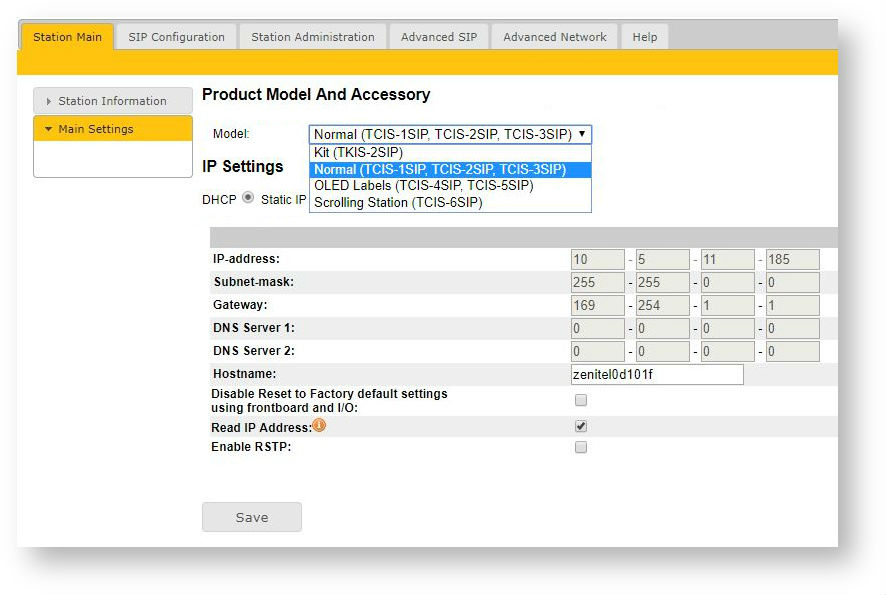
Administer SIP Settings
Under the SIP Configuration tab:
- Select SIP Settings to configure the parameters in the Account Settings section
- Set the Turbine stations support UDP, TCP and TLS configuration options
- For TCP and TLS options, it is necessary to set Outbound Proxy to have the same value as Server Domain
UDP Outbound Transport
- Display Name: Enter the desired name.
- Directory Number (SIP ID): Enter a user extension administered from section "Configure SIP User".
- Server Domain (SIP): Enter the Domain of Session Manager.
- Authentication User Name: Enter a user extension administered from section "Configure SIP User".
- Authentication Password: Enter the Communication Profile Password from section "Configure SIP User".
- Outbound Proxy (mandatory for TCP and TLS, optional for UDP): Enter the IP address of Session Manager and 5060 as the Port for UDP/TCP
TCP Outbound Transport
- Display Name: Enter the desired name.
- Directory Number (SIP ID): Enter a user extension administered from section "Configure SIP User".
- Server Domain (SIP): Enter the Domain of Session Manager.
- Authentication User Name: Enter a user extension administered from section "Configure SIP User".
- Authentication Password: Enter the Communication Profile Password from section "Configure SIP User".
- Outbound Proxy (mandatory): Enter the IP address of Session Manager and 5060 as the Port for TCP
Secure SIP Configuration with Secure RTP
- Display Name: Enter the desired name.
- Directory Number (SIP ID): Enter a user extension administered from section "Configure SIP User"
- Server Domain (SIP): Enter the Domain of Session Manager.
- Authentication User Name: Enter a user extension administered from section "Configure SIP User"
- Authentication Password: Enter the Communication Profile Password from section "Configure SIP User"
- Outbound Proxy (mandatory): Enter the IP address of Session Manager and 5061 as the Port for TLS
- SIP Scheme: Select sips from the dropdown
- RTP Encryption: Select srtp_encryption from the dropdown
- SRTP Crypto Type: Select from the dropdown as shown
- TLS Private Key: Select from the dropdown as shown
Add certificate on Turbine station
Using SIP TLS requires you to upload a certificate to be able to do encrypted authentication and communication.
This step must be done before the station is able to register to the PBX.
- Select SIP Configuration tab and from the left hand menu
- select Certificates.
The Turbine certificates are listed.
- Click on Choose file and browse to the location of the root certificate .pem file.
- When selected click on the Upload button
The root certificate is uploaded and is shown in the list (default.pem).
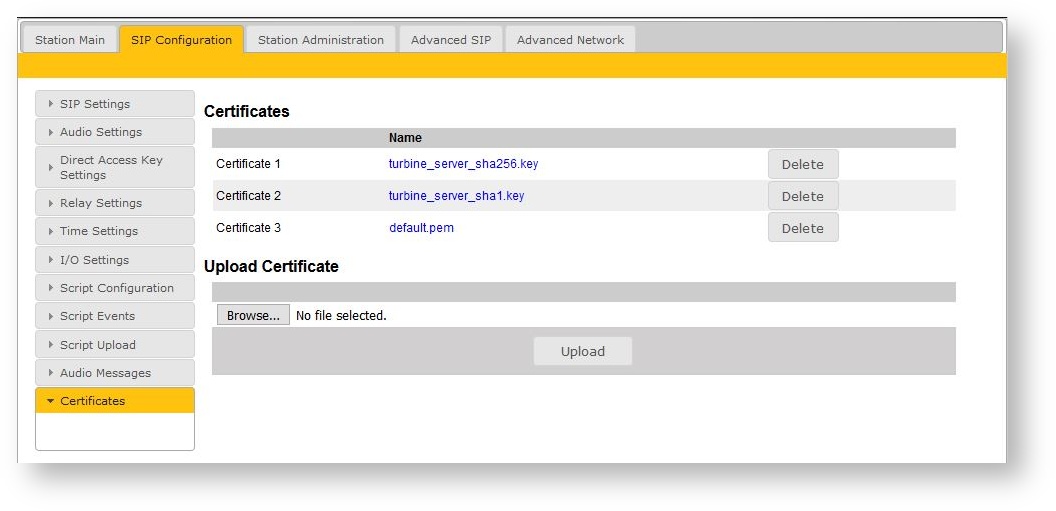
- Reboot Turbine station ( Station Administration → Reboot → Reboot )
Configure Direct Access Keys
Under the SIP Configuration tab:
- Select Direct Access Key Settings > DAK 1 to configure it
- In the Idle field select Call To from the dropdown and enter the extension number to be called when the DAK 1 key is pressed
- In the Call field select Answer/End Call and On Key Press
Backup Domain Configuration
This section provides configuration procedures for configuring redundacy, backup, and server for the Turbine station.
Select SIP Configuration > SIP Settings to configure the following in the Account Settings section
All configuration is the same as in section 4.3 with additional fields for configuration Backup and Backup 2 servers:
Backup Domain (SIP): This is the secondary (or fallback) domain. If the station loses connection to the primary SIP domain, it will switch over to the secondary one. This can be either an IP address in regular dot notation or hostname.
Backup Domain 2 (SIP): This is the tertiary SIP domain used as backup in case the primary and secondary domains fail. This can be either an IP address in regular dot notation or hostname.
Outbound Backup Proxy (mandatory for TCP and TLS, optional for UDP transport protocol): Enter the IP address of Session Manager and 5060 (5061) as the Port for UDP/TCP (TLS)
Outbound Backup Proxy 2 (mandatory for TCP and TLS, optional for UDP transport protocol): Enter the IP address of Session Manager and 5060 (5061) as the Port for UDP/TCP (TLS)
Select Registration Method from the dropdown:
- Parallel
- In Parallel mode the IP station will try to be registered to all configured SIP servers at the same time. The station will use the primary SIP server for outgoing calls if available, otherwise it will use the next available backup server. In this mode, the station can receive calls from multiple SIP servers at the same time. This mode is not recommended in a Cisco Unified CallManager cluster with multiple publishers and subscribers.
- Serial
- Serial registration means that the station will always register to the next available SIP server. The station starts by registering to the primary SIP server, then if the station loses contact with the primary SIP server it will register to the backup server. If the station loses contact with the backup server, then it will register to the secondary backup server. If the station loses contact with the secondary backup server, it will register to the primary SIP server.
- Top-Down
- Top-Down registration means that the station will try to be registered to the primary SIP server, but periodically poll the backup servers to check that they are up without registering. If the primary SIP server shuts down, then the station will register to the next backup server that is up. If the primary SIP server starts up, the station will unregister at the backup server and switch back to the primary server.
- Cisco
- Cisco registration is the same as Top-Down for the primary and backup servers, while the secondary backup server will register to its configured server in parallell.
Verification Steps
This section provides the tests that can be performed to verify the correct configuration of Session Manager and the Turbine station.
Verify Avaya Aura® Session SIP Endpoint Registration
In the System Manager web interface:
- Select Session Manager > System Status > User Registrations.
- Verify that Turbine station endpoints are successfully registered as shown below.
Verify Turbine Station SIP Registration
In the Turbine station web interface:
- Select Station Main > Station Information
- Verify that the status shows Registered under Server Domain (SIP)
Place a call to another endpoint to verify basic call operation.

Verify Successful Calls
Place a call to and from the Turbine station endpoint. Verify that 2-way audio can be heard and validate that the call terminates successfully.
Related Articles
This section references the Avaya and Zenitel product documentation that are relevant to these Application Notes.
The following Avaya product documentation can be found at http://support.avaya.com.
[1] Administering Avaya Aura® Session Manager Release 7.1.1, August 2015
[2] Administering Avaya Aura® Communication Manager, Document ID 03-300509
[3] Avaya Aura® Communication Manager Feature Description and Implementation, Document ID 555-245-205
[4] Administering Avaya Aura® System Manager 7.1.1, October 2017
The Zenitel Turbine documentation can be found at http://www.zenitel.com.


